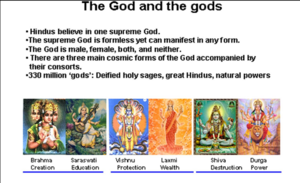Talk:Saguṇa Brahman as Īśvara or Bhagavān:Relationship between Devatās and Brahman
By Sri Vishal Agarwal
The word Devatā can of course refer to Brahman itself. But what is the relationship of other Devatās to Brahman? Sages explain this in the following ways.
Devas are Like the Chiselled Facets of the Same Diamond: The different Devatās are like different chiseled facets of the same gem. When we look at a diamond from a particular direction, then depending on where the light is falling from, only one facet may shine brightly. Similarly, these different Devatās are different facets or manifestations of one Brahman – sometimes we see one facet and at another times we see the other facet. However, we should keep in mind that all these facets have at their base the same beautiful diamond. Admiring the glitter of one facet is a way of admiring the entire gem. But only a foolish man will say that no other facet of the gem will glitter other than the one that is shining right now.
Different Devatās represent Different Natures or Functions of the same Brahman: A single person may have different names representing his different qualities and relationships and therefore that person can be called out but all these names. E.g., A boy named Shyam is addressed as ‘son’ by his parents, ‘brother’ by his siblings, ‘Dad’ by his kid, ‘husband’, by his wife, ‘master’ by his servants, and has nicknames like ‘handsome’ because he is pleasing in appearance, ‘Yankee’ because he is from New York and so on. Similarly, the different names of Brahman represent his different natures and relationships to us. Bhagavān is infinite and therefore, we cannot put a limit on his names. If we say that Bhagavān answers only when addressed by one particular name, then we are limiting him, and are trying to control his freedom because of our own human limitations.
The following passages from the Purāṇas illustrate why the different attributes of the same Brahman are reflected in Its different names:
Meanings of the names of Bhagavān: From Vāyu Purāṇa He is called 'Ātman' because whatever He attains (āpnoti), takes up (ādatte) and exists (asti) for the (enjoyment of) objects, that is his permanent being. Vāyu Purāṇa 1.5.32 He is called Ṛṣi because He goes everywhere. He is Viṣṇu because he pervades everything.
He has the lordship over everything. He is the Bhagavān of the Physical body etc. ''Vāyu Purāṇa 1.5.33
He is called Bhagavān because there are such (excellences) in him. He is Rāga (Bhagavān of passion) because he controls passion. He is Para (Supreme) because he is the cosmic being. He is Om because he protects (all). ''Vāyu Purāṇa 1.5.34
He is Sarvajña because he knows everything. He is sarva because everything originates from him. As men originate from him, He is called Nārāyaṇa. Vāyu Purāṇa 1.5.35
Because He is the first to manifest, he is called the first Bhagavān. He is called Aja because he is not born (is self-existent). Since He protects his subjects, He is called the Prajāpati. ''Vāyu Purāṇa 1.5.37
He is called Mahādeva because he is the greatest deity amongst the Devas. He is Īśvara because he is the Bhagavān of the worlds and because he is not subject to other's control. ''Vāyu Purāṇa 1.5.38
He is called Brahman because of his hugeness. He is called Bhūta because of his (eternal) existence. He is Kṣetrajña because he knows the unmanifest cosmic nature. He is Vibhu because he is omnipresent. ''Vāyu Purāṇa 1.5.39
Because he lies in the subtle body (called Pur), he is called Puruṣa. He is called Svayambhū because he is not procreated and because he exists before the creation. ''Vāyu Purāṇa 1.5.40
He is called Yajña because worship or sacrifice is offered to him. He is Kavi because he is omniscient. He is Kramaṇa because he is worthy of being approached and due to his patronage of castes he is called Āditya, Kapila and Agni. His womb was golden and he was born of a golden womb, so he is called Hiraṇyagarbha in this Purāṇa. ''Vāyu Purāṇa 1.5.41-42
We have heard the epithet of waters called Nara, and that they are minute or subtle bodies. Since he lies in waters, he is therefore called Nārāyaṇa. ''Vāyu Purāṇa 1.6.5
This does not mean however that these Devas representing different characteristics of Brahman are merely abstract figures. With regard to Ṛgvedic Deities, a scholar says: “Because it is the power symbolized by a devi devta that is emphasized, personal characteristics of the deities are usually ignored. For most deities, no important biographical data are given; nothing about their origins, and next to nothing about their personalities, are indicated. There is no sense of a divine family or of a hierarchy of power among the deities. Despite their lack of personality, however, the Vedic deities are not abstract, for the powers they symbolize are directly experienced by every person, and the devi devta lives in the immediate experience.”[1]
Analogy of Different Names of Water: Swami Ramakrishna Paramahamsa gave another analogy in which he pointed out that the same substance namely water, is referred to as ‘Jala’ by the Hindus, ‘Pānī’ by the Muslims,[2] and also by other names like ‘Nīra’ and so on. But these different names all belong to the same substance water. Likewise, the Bhagavān of Hindus, Allah of Muslims, Waheguru of Sikhs and Jehovah or Yahweh of the Christians and Jews is one and the same Divine Being.
This analogy of the One Divinity possessing many different names has been given as early as the Vedic scriptures in Hindu Dharm. ''Ṛgveda 1.164.46 Several scriptural statements may be quoted below to illustrate this point: They call Him Indra, Mitra, Varuṇa, Agni, and he is the Divine beautiful winged bird (the sun with beautiful rays). The sages describe one and the same Agni in various ways and call it Agni, Yama and Mātariśvā. ''Ṛgveda 1.164.46
Agni itself is Indra, Vāyu, Brahmā, Viṣṇu and Bṛhaspati. ''Ṛgveda 2.1.3
Varuṇa and Mitra are but functional manifestations of Agni. ''Ṛgveda 2.1.4
Viṣṇu, Rudra and Marut are also functional manifestations of Agni. ''Ṛgveda 2.1.6 That (Supreme Being) is Agni; that is the Sūrya; that is the Vāyu; that is the Candramā; that is Jyoti; that is Brahman; and that is Prajāpati. (Mādhyandina Yajurveda 32.1) The perception of the worshipper makes the ONE Deity appear as three, but in their ontological essence, they are ONE. ''Bṛhaddevatā 2.18
The same sentiment has been echoed in later times by Saints like Kabir and Guru Arjan Dev (the fifth Sikh Guru) to argue that human beings are not intrinsically different as Hindus and Muslims because He who is Rām is the same as Allah and to Him alone belong our bodies as well as our life. In modern times, this eclecticism and acceptance of diversity is seen in the everyday behavior of peoples. Many peoples will add images from Christianity (like a picture of Jesus Christ) in their private home shrines, and will not criticize Abrahamic religions even if these religions are busy undermining and converting poor peoples in many areas even using money, fraud and force. In fact, it is quintessentially Hindu to honor all religions and their ‘Bhagavān’.
Different Devatās are like limbs of the body of the same Brahman: The different limbs of our body are parts of the body, but they function together so that the body can perform its role as a whole. In a similar way, the different Devatās represent different ‘limbs’ of the whole that is Brahman. Note that this is just a metaphorical description because Brahman does not really have a body like us. The following passage from Nirukta of Ṛṣi Yāska is very eloquent on this matter:
In His body existed the three and thirty Devas by dividing themselves into its limbs. They alone who knew Brahman knew the thirty three Devas. ''Atharva Veda, Śaunaka Saṃhitā 10.7.27
On account of superb excellence of the Divinity, One soul (i.e., the All-pervading Soul) is extolled in various ways. The other (manifest) Bhagavāns are just like the limbs of the Great Soul, the secondary members of the body. The specialists in this branch of study (= spirituality) observe that the Sages praise the beings according to the plurality and Universality of their intrinsic nature. The Bhagavāns are (figuratively described in the Veda as) born from each other (e.g., Ṛgveda 10.72.4). The Bhagavāns are the primary source of each other. They owe their birth, i.e., coming into being, to their specific functions as well as to the (Universal) Soul. Soul alone is their chariot, horse, weapon and arrow, i.e., these things which are not different from the soul are only figurative appellations in their descriptions. ''Nirukta 7.4
An extension of seeing the different Devatās as limbs or parts of the same Brahman is in that several Hindu scriptures advocate seeing these different Devatās in the corresponding limbs of our own body as a spiritual discipline. See the section on Saguṇa Brahman as Antaryāmī for more details.
Analogy of the Sameness of Water in Different Water Bodies: Another example given in the Hindu tradition is that of the sameness of water, whether it is in a pond, in a river, the ocean, in the rain or in the dew drops. Although the external forms of all these bodies of water are different, the essence is the same. It is the same ‘substance’ that is chemically written as H₂O, to use modern parlance. Likewise, the different Devas are in essence the same Brahman, only their external forms are different. A similar analogy is made with regard to fire also. One can light different fires at different spots, but the fire or its essence is the same, no matter where it is lit.
And assumes several shapes and configurations, likewise the Ātman too takes on different forms (in different bodies) but is not exhausted by these forms. [3]People may worship Brahman in different ways or call it differently due to their different cultural background or perceptions, but in reality, all these Devatās are the same Brahman.
“For indeed Agni is that Bhagavān. His are the names: as the easterners (prācyāḥ) call him ‘Śarva’ (all), Bāhlika-s (call him) ‘Dhava’ (one who shakes), ‘Rudra’ (one who causes weeping), ‘Paśūnāmpatiḥ’ (the Bhagavān or the protector of beasts), ‘Agni’ (the first leader, he who was there at the outset).” ''Yajurveda (Kāṇva Śatapatha Brāhmaṇa) 2.7.1.7
Devas as Personified Symbols of the Ultimate Divinity: They said: ‘Revered one, you are the teacher, you are the teacher. What has been said has been duly fixed in mind by us. Now answer a further question. Fire, air, sun, time, whatever it is, breath, food, Brahmā, Rudra, Viṣṇu — some meditate upon one, some meditate upon another. Tell us — which one is the best for us?’ Then he replied to them: “All these are merely the manifest/frontal forms of Brahman, the Immortal, the Formless. To whichever form each man is devoted here, in the realm of that deity does that man rejoices. For it has been said — ‘Verily, this whole is Brahman. Verily, these, which are its manifest forms that one meditates on, worships and discards. For by meditation upon these forms, one moves into higher and higher realms. And when all things perish, he attains unity with the Puruṣa!” ''Yajurveda, Maitrāyaṇīya Upaniṣad 4.5–6
In the Gītā, Kṛṣṇa says that we should be aware that all the ‘gods’ eventually get all their powers and abilities to bless their worshipper from the One Bhagavān (Brahman):
Those whose knowledge has been affected by different desires seek refuge in other Bhagavāns. They observe diverse rituals relevant to the tradition of worship of these respective Bhagavāns, being constrained by their own material nature. ''Gītā 7.20
Whichever form (Bhagavān) such a devotee seeks to worship with faith, in that very form I make his faith unswerving (or firm). ''Gītā 7.21
Endowed with that faith, he seeks to worship that form (Bhagavān) and through that, he fulfills his desires, which are really fulfilled by Me (through the medium of that form or Bhagavān). ''Gītā 7.22
And in fact, the offerings of these worshippers to various Devas are enjoyed by none other than the One Bhagavān— Son of Kuntī, even those who perform yajñas to other Devas with faith also worship Me alone, even though it does not follow the correct procedure. ''Gītā 9.23
Because I am indeed the enjoyer and the Bhagavān of all the yajñas. But these men do not know Me as I really am. Therefore, they fall. ''Gītā 9.24 And, a modern scholar therefore explains the higher Hindu principle that worship of these Deities is worship of the Divine only if they are related to the Divine. Otherwise, it is merely a transaction, like the one we carry out in our daily lives with those who are more powerful than us:
“The recognition that the Bhagavāns are not ultimate sometimes leads to a kind of religious atheism, where the Bhagavāns are abandoned, ignored, or even repudiated (as in Buddhism and Jainism) in favor of a nonpersonal, but still spiritual, ultimate reality. Vedānta and some forms of Yoga are good examples of this tendency. But even among the devotees of Kālī, Śiva or Viṣṇu, these deities are recognized not as the ultimate reality but as personified symbols of the ultimate. This would be like a Jew, Christian, or Muslim declaring that Bhagavān is not the ultimate reality but, rather, a symbol of the ultimate. To the extent that the symbol participates in the reality that it symbolizes, Viṣṇu (or Bhagavān) is the ultimate. But to the extent that the reality symbolized goes beyond the symbol, Viṣṇu (or Bhagavān) is less than ultimate.”[4]
Analogy of Sun and its Rays: The various Devatās and Brahman are like the rays of the Sun and the Sun itself respectively. It is difficult, if not impossible, to experience and see the sun directly, but we can easily experience it through its rays which have the sun’s warmth, light and other properties. Although the number of rays is infinite, they all emanate from the same source – the one Sun. [5]In the same way, all Devas represent Divine qualities of the same Brahman, from Whom they all emerge.
“(It is) The Supreme Being (Who) first spread out the mighty powers collected in Him (It is) The Supreme Being (Who) first spread out the heavenly lights everywhere Verily, The Supreme Being was born as first Bhagavān of all that exists Who, then is fit to be this Supreme Being’s rival” Atharvaveda Paippalāda VIII.8.1
The relationship between Brahman, Īśvara and the Devas may also be summarized pictorially below in a summary manner:[6]
References[edit]
- ↑ Koller, John M. The Indian Way. New York: Macmillan Publishing, 1982, p. 25.
- ↑ The word ‘Paani’ for water is also a Sanskrit word and there is nothing particularly Islamic about it. What Swami Ramakrishna Paramahamsa referred to was that the Hindus in his vicinity preferred to use the word ‘Jala’ whereas the Muslims tended to use the word ‘Paani’.
- ↑ Katha Upanishad 5.9-10
- ↑ Koller, John M. The Indian Way. New York: Macmillan Publishing, 1982, p. 28.
- ↑ For similar idea, refer Sage Shaunaka’s Brihaddevatā 1.61-63
- ↑ This pictorial was created by Dasharath Lohar.



